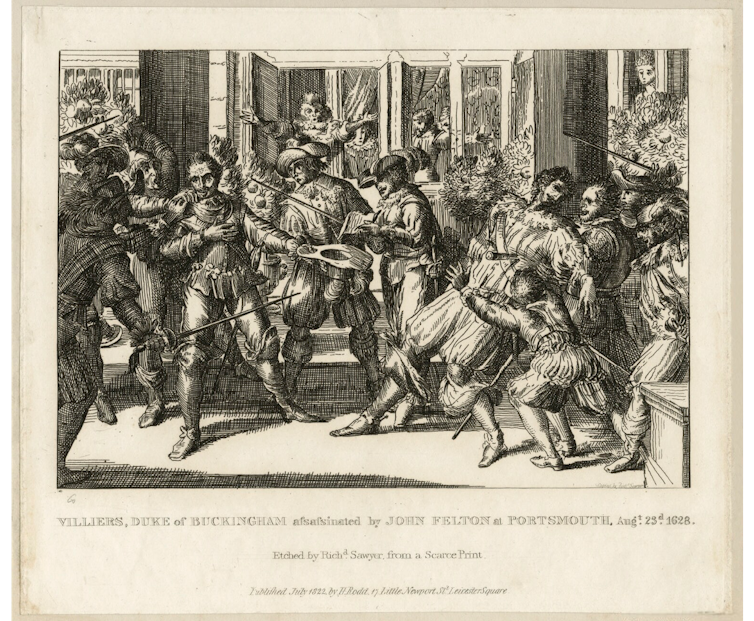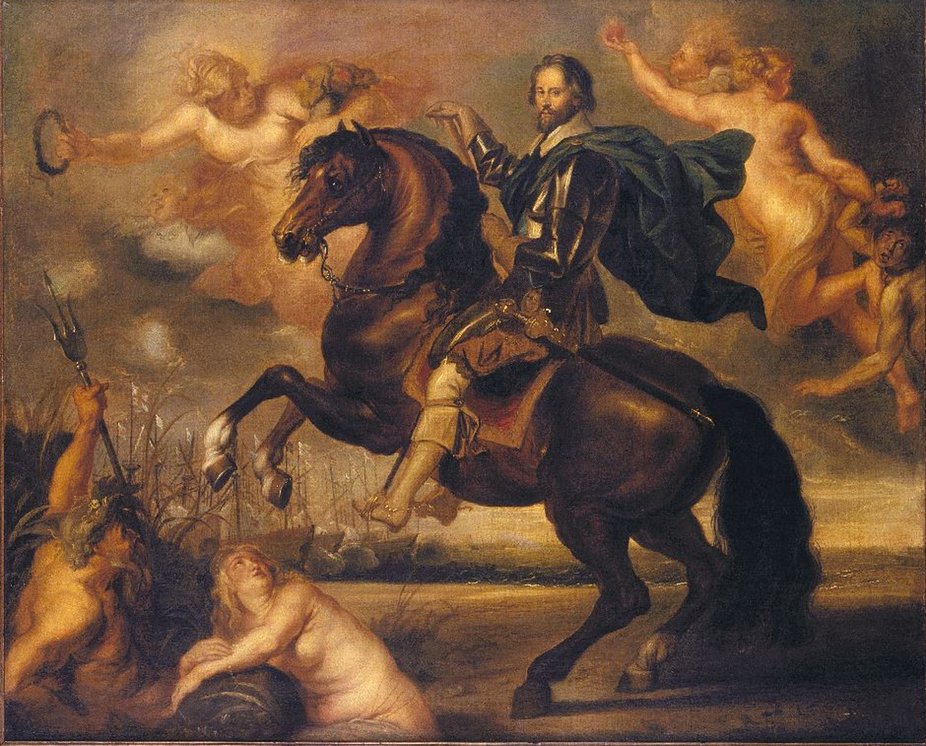See if you can guess who this describes: a politician adored by his supporters but loathed by his enemies. A man accused of corruptly favouring his cronies and his relatives. A vain, preening man said to glory in the ostentation of his wealth and who loved to acquire property. A man who sought to monopolise power, who some think betrayed his country to the national enemy and who wanted to magnify his nation’s standing in the world – but ended up reducing it and damaging trade. A man who was lampooned mercilessly – and who faced impeachment.
I’m not describing Donald Trump – but George Villiers, first duke of Buckingham (1592-1628). The impeachment of the current US president nevertheless gives us reason to look at the role of impeachment more generally in the British context – which is where they began (at least, in the form with which we are familiar). The central allegation against Trump is abuse of office, which also ran through the charges against Buckingham.
Buckingham was one of the most controversial figures of his day. Rising from relative obscurity, he acquired enormous wealth as a result of his close friendship (some alleged more) with first king James I and then Charles I. At the height of his power in the mid-1620s, he enjoyed an income four times that of the wealthiest landowner, though he spent money so freely that he was always in debt.
Impeachment was a parliamentary trial – a prosecution brought by the House of Commons and judged by the Lords. The process began in the medieval period in order to prosecute corrupt, over-mighty officials for “high crimes and misdemeanours”. This was a term we are hearing a lot of in the US Senate’s impeachment proceedings against Trump. It was a catch-all term, but was intrinsically linked to accusations of corruption and betrayal.
Medieval misgovernment
In 1376, the so-called “Good Parliament” was opened by its speaker launching an attack on the royal court’s corruption and calling for close scrutiny of the royal financial accounts. This led to the first impeachment: of Lord Latimer who – along with others – was accused of selling the country to the enemy, taking bribes, pocketing fines that were due to King Edward III and charging the king extortionate interest for loans he made.
But impeachment fell out of use between 1453 when the Wars of the Roses took redress onto the battlefield and thereafter Tudor power dominated. It was revived in 1621 when parliament wanted the scalps of corrupt officials linked to Buckingham.
The first under attack was Sir Giles Mompesson, who had abused a monopoly on the licensing of inns (and was a relative of Buckingham). The second target was the Lord Chancellor, Francis Bacon – the man sometimes credited with popularising the scientific revolution, but who was also a politician with powerful enemies. Bacon was accused of accepting bribes, though his closeness to Buckingham was perhaps the most significant factor in the proceedings. Impeachment was always political.

Francis Bacon: philosopher and grifter?
The attempted impeachment of Buckingham himself came in 1626. Charges were drawn up against him alleging that he had monopolised offices, favoured his kin at the expense of the kingdom, bought and sold offices and misspent public money. Further, it was charged that he had damaged British trade and overseas interests, betrayed the nation as commander of the naval forces, taken bribes, perverted the honour of the peerage by selling honours, misspent Crown money and failed to keep proper accounts.
It was even suggested that he may have tried to poison James I. Buckingham’s mind was said to be “full of collusion and deceit”. Buckingham was an over-mighty politician who threatened and corrupted the constitution.
Buckingham was a showman politician who loved displaying power and wealth. As one MP put it:
Infinite sums of Money, and Mass of Land … have been heaped upon him, and how have they been employed? Upon costly Furniture, sumptuous Feasting, and magnificent Building.
Buckingham refuted the impeachment charges, alleging that “common fame” was the only proof against him – and that it was fake news. But parliament was not to be deflected by his protestations. MPs drew up a remonstrance and declared the duke to be the single cause of the nation’s ills: “The great enemy of the kingdom”.
The House of Commons resolved that “the excessive power of the Duke of Buckingham, and the abuse of that power, are the chief causes of these evils and dangers to the King and kingdom”. And yet, after all, the impeachment failed. The duke still had the king’s ear and Charles I dissolved parliament.
Too hard to prove
Why does this history matter? Impeachment was used in Britain repeatedly after 1626 against holders of office, until 1806 when Lord Melville, who had also been accused of corruption, was found not guilty. It was a difficult process to pull off. The definition of “high crimes and misdemeanours” was not to be found in statute law. As a parliamentary trial, impeachment was intrinsically wrapped in politics and therefore only ever semi-judicial.
The failure to convict in 1806 came a decade after another major impeachment, of Warren Hastings, which had also ended in acquittal. So 1806 was the last time the process was attempted in Britain. A 1999 report from the Joint Committee on Parliamentary Privilege states that “the procedure may be considered obsolete”.
But it is a different matter in the US. The practice transferred across the pond when, drawing on British law, impeachment was written into Article 1 of the 1787 constitution of the recently liberated United States, 20 years before the British abandoned it.
But the British story has darker lessons too. In 1628, two years after the failed impeachment, Buckingham was assassinated, his killer inspired in part by the Commons’ remonstrance.

The assassination of the Duke of Buckingham in 1628. Richard Sawyer, National Portrait Gallery.
Clearly no one would ever want that history to repeat itself – but it is a warning about the height to which passions could be roused by impeachment and about how the perceived frustration of the legal process could stoke disillusionment, resentment and desperation.
And a bloody end was not just meted out against the duke himself. Two decades after Buckingham’s impeachment, Britain was not just engaged in a war of words or a legal battle but embroiled in civil war, mired in the sense that government as a whole had become corrupted. Impeachment may thus be a moment to step back and reconsider the wider health of political culture and discourse.



 Honduras Election Turmoil Intensifies as Nasralla Blames Trump for Shift in Results
Honduras Election Turmoil Intensifies as Nasralla Blames Trump for Shift in Results  UN General Assembly Demands Russia Return Ukrainian Children Amid Ongoing Conflict
UN General Assembly Demands Russia Return Ukrainian Children Amid Ongoing Conflict  Trump Administration Tightens H-1B Visa Vetting With New Focus on Free Speech and Censorship
Trump Administration Tightens H-1B Visa Vetting With New Focus on Free Speech and Censorship  U.S. Expected to Expand Travel Ban to More Than 30 Countries
U.S. Expected to Expand Travel Ban to More Than 30 Countries  China’s Expanding Maritime Military Presence Alarms Taiwan and Japan
China’s Expanding Maritime Military Presence Alarms Taiwan and Japan  Trump Claims He Will Void Biden Documents Signed with Autopen
Trump Claims He Will Void Biden Documents Signed with Autopen  Pentagon Probe Finds Hegseth’s Use of Signal Risked Exposing Sensitive Yemen Strike Details
Pentagon Probe Finds Hegseth’s Use of Signal Risked Exposing Sensitive Yemen Strike Details  California Launches Portal for Reporting Alleged Misconduct by Federal Immigration Agents
California Launches Portal for Reporting Alleged Misconduct by Federal Immigration Agents  Bitcoin Smashes $93K as Institutions Pile In – $100K Next?
Bitcoin Smashes $93K as Institutions Pile In – $100K Next?  Ethereum Ignites: Fusaka Upgrade Unleashes 9× Scalability as ETH Holds Strong Above $3,100 – Bull Run Reloaded
Ethereum Ignites: Fusaka Upgrade Unleashes 9× Scalability as ETH Holds Strong Above $3,100 – Bull Run Reloaded  China Urged to Prioritize Economy Over Territorial Ambitions, Says Taiwan’s President Lai
China Urged to Prioritize Economy Over Territorial Ambitions, Says Taiwan’s President Lai 





























